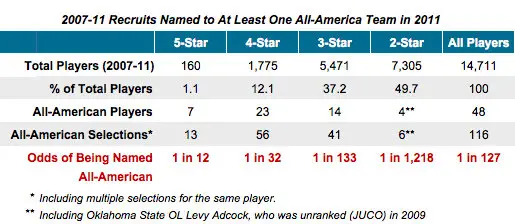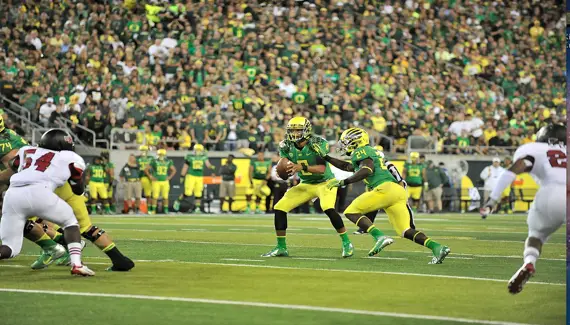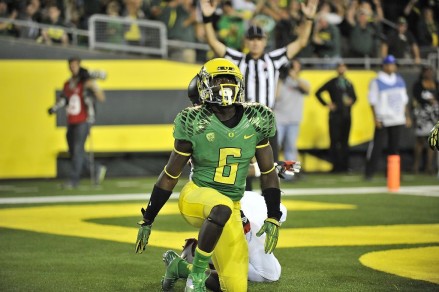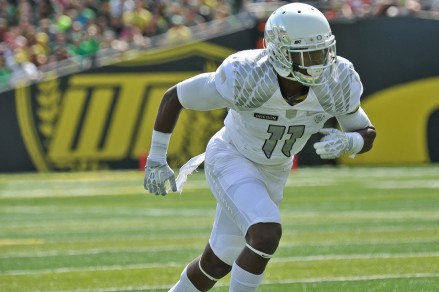“Recruiting rankings don’t matter”.
Typically, this is said by fans after their favorite team picks up a commitment from a two or three-star player who is “underrated”. So, is it true? Do recruiting rankings act as a good predictor of on-field success? I defer to Matt Hinton, who wrote a great five-part series called “Star Power.” A part of the Dr. Saturday blog, the series can be found here: 1 2 3 4 5. As the most comprehensive study of its kind, it is well worth the read. Hinton’s opening statement says it all.
“If you didn’t know any better, you might be convinced all those recruiting stars everyone gets worked up about every winter didn’t correspond to future success at all,” he said. “Fortunately, because we’ve been bestowed by the American education system with the magic of basic arithmetic, we do know better.”

DeForest Buckner
Hinton goes on to use an army of statistical charts, graphs and models to support his conclusion that recruiting rankings are not only valuable, but “have considerable predictive power” for both individual players and entire teams. Dave Bartoo, creator of the “College Football Matrix,” claims that Hinton’s findings corroborate eight years of profiling the recruiting landscape:
“Recruiting rank, when correctly adjusted, is the single-best tool for predicting game outcomes, ” Bartoo says. “In the last seven years, 84 percent of all conference champions were in the top third of conference recruiting and no team has made the National Championship Game without being in the Top-16 of our adjusted four-year recruiting rankings.”
If you’re a fan of college football, check out CFBMatrix.com. Bartoo’s adjusted recruiting rankings are consistently good at predicting the results of FBS games, months in advance. His predictions have proven more accurate than those of any other national publication. Many fans won’t like the conclusions that Hinton or Bartoo have come to, but the fact is, talent wins.
Despite the efforts of many to look at recruiting rankings objectively, it’s not hard to find those who critique the process or the talent evaluators themselves. Since assessing a high school player’s worth as a prospect includes projecting things that can’t be known, like future physical development and mental makeup, there’s certainly some room for criticism.
The subjectivity of ranking a 17-year-old based on his potential also accounts for the variance between how the different sites rank the same player. Nonetheless, while improvements can always be made (especially to the evaluation process), objective measures have shown that the big recruiting sites are good at what they do. 247, Scout, Rivals and ESPN are all great resources. They give the average fan access to comprehensive ranking systems that were hidden away in the offices of D-I recruiting coordinators until only recently.
The analysts and talent evaluators who compile the rankings that you and I scrutinize so heavily didn’t just stumble into their jobs by dumb luck.
Recruiting services are businesses.
The evaluators who assign rankings aren’t saying, “ok, these are the four stars…” and then drawing names from a hat. Most recruits are now ranked after their junior seasons. Then they’re re-evaluated after spring camps, again after the summer-circuit, yet again after their senior seasons and finally, after any all-star games they play in. By the time signing day rolls around, the experts feel good about their respective rankings, which have likely been discussed at length among colleagues in the recruiting community. Typically, you’ll notice that a player is ranked similarly across all of the respected sites. Are there exceptions? Of course, but usually the analysts agree.
In addition, the star ratings are valuable because they group players by tier. If the No. 10 receiver and No. 35 receiver are both four-stars, then there probably isn’t a huge difference between the two. Each site compiles their player rankings differently, so it’s telling that more often than not, they’re quite similar. Disparities do occur, though, which makes it important to get a comprehensive look at a player’s ranking across all of the different services.
Now, scouts will always over and under-rate individual players, but so does every single college football coach. When you’re rating hundreds of players every year, mistakes are inevitable. Rankings aren’t everything, but they shouldn’t be disregarded either; they’re the best resource we have for looking at the talent level of college football teams.
College coaches are not dumb. They know that winning consistently requires talent, which they’ll go to great lengths to acquire. As evidenced by offer lists, interest level in a recruit often correlates to their ranking. Many pass this off as conspiracy, saying that recruits are ranked based on their offer lists, but that’s nonsense. Simply put, the coaches and recruiting analysts usually see the same thing. The potential of a four-star player with a bunch of offers is obvious to the scouts who gave him four stars and the coaches who offered him scholarships.
Additionally, there are always a number of players each cycle who have long and impressive offer lists yet maintain unimpressive star ratings across multiple recruiting sites; if players were ranked on offer lists then this type of thing wouldn’t happen.
The point is, star ratings are the result of expert analysts evaluating a player time and time again, usually based on 2+ years of film, firsthand evaluations (at camps and games) and discussions with colleagues. There are certainly biases among the different recruiting sites and analysts, which is another reason that I think it’s important to use a comprehensive approach when looking at recruiting rankings, but I don’t believe any particular bias renders an entire ranking system useless.
“If you consider the initial grade as a kind of investment – a projection of how likely a player is of becoming an elite contributor compared to the rest of the field – well, you’d put your money with the ‘experts’ over the chances of finding the proverbial diamond in the rough every time,” said Hinton.

http://sports.yahoo.com/blogs/ncaaf-dr-saturday/star-power-defense-recruiting-rankings-214251813.html
Are there certain players overlooked by recruiting sites that a coach might absolutely love? Of course, but most of the time, a coach will think more highly of a 4-star than they will of a 3-star because the 4-star is higher on the coach’s big board too! There are other factors that come into play like character, grades and fit, but raw talent is king. The players who look like the best prospects in high school usually become the best players in college. There will always be teams that over or under-perform based on things like system, coaching and chemistry, but as a general rule, nothing is as important as talent. It’s not a coincidence that no team outside of the CFBMatrix “4-year moving average” Top-16 has ever played in a BCS national championship game. Talent doesn’t guarantee success, but it is a prerequisite.
“Bigdukesix” of Recruitocosm writes his own analysis of the star-system. Using Hinton’s studies to support his findings, the author concludes by saying that, “being a decently-talented, well-coached team will only take you so far. At some point you run into a well-coached team with superior athletes and get ground up and spit out…recruiting success is necessary but not sufficient for consistent team success”.
There are always exceptions to every rule, and you can object to many of the statements I’ve made here using specific examples with the help of hindsight, but the fact is, in big time college football, talent precedes winning. The best way to measure that “talent” is to use the star-ratings awarded by professional analysts and talent evaluators since we don’t have access to the recruiting offices of D1 schools. Hinton puts it plainly when he says that, “it’s a simple equation: the better your recruiting rankings by the gurus, the better your chances of winning games.”
In Year 2 of these rankings, I plan to once again look at the talent-level of each team in the Pac-12 in order to try and better understand what the future of the conference holds. We’ll look at each team’s overall talent level by accounting for all scholarship players on every roster in the conference. Instead of only looking at recruiting rankings, these rankings will also account for attrition; a 5-star player is no good to a team if he’s no longer on the roster.
Beginning next week, the countdown will be begin. Each team analysis will begin with a screenshot of an excel spreadsheet which breaks down players by class and recruiting rank. This user-friendly visual makes it easy to see how talent is distributed throughout each roster. I’ve come up with a tier-system that uses rankings from Rivals, Scout, 247 and ESPN. The system accounts for discrepancies between the services and is fairly simple:
- Tier-E: 5-star rating by at least one service
- Tier-1: 4-star rating by at least two services
- Tier-2: 4-star rating by one service
- Tier-3: 3-star rating by at least two services
- Tier-4: 3-star rating by one service
- Tier-5: No 3-star rating by any service
We’ll see you next Monday as we begin the “Pac12 Talent Rankings” countdown, starting with #12, #11, #10 and #9.
*Featured image courtesy of Kevin Cline
____________________________________________________________________________________________________________________________________________________________________________________________
ANNOUNCEMENTS
*If you would like to join the other 80+ volunteers at FishDuck.com, and have five hours a week to donate… we have slots open for volunteer Editors, Writers, Analysts, Photo Archivists and Social Media Associates. Can you help us manage people? Consider our volunteer Sales Manager and HR Manager positions and give some time each week to help young associates learn! E-mail us at charles@fishduck.
*Don’t miss our football analysis every Tuesday, our Recruiting Update every Wednesday and our new Chip Kelly updates every Friday!
Related Articles:
Chip Kelly Update: Everything's Good Again ...
Chip Kelly Update: Wailing and Gnashing of Teeth
Shock and Awe -- The Oregon Ducks' Football Hangover Effect
Despite Lopsided Score, Georgia State "Never Stopped Believing"
Hope Springs Eternal for Ducks
Incompetent Pac-12 Officials: How Do You Miss ALL of THIS?
Chris was born in Montevideo, Uruguay, but made his way to Oregon by the age of five, when he attended his first game at Autzen Stadium. A huge sports fan at a young age, Chris grew up playing football, basketball and golf. Although realizing he isn’t likely to play in the NFL or NBA, Chris still holds on to hopes of being a professional golfer should his unfortunate putting woes take a turn for the better. A bit of a platypus, he attended both Oregon State and Oregon during his collegiate days where he earned a business degree in Finance and Business Administration. Chris works for Daimler Trucks North America in Portland, and plans to get his MBA from the University of Oregon.
Chris has been an active member in the recruiting community since 2005. He studies the intricacies of recruiting and is particularly intrigued by talent evaluation techniques. He is currently working on developing his own scouting reports for every scholarship player on the UO roster. Chris lives with his wife, Katrina, and his two-year-old son Lucas (a future dual-threat QB).




